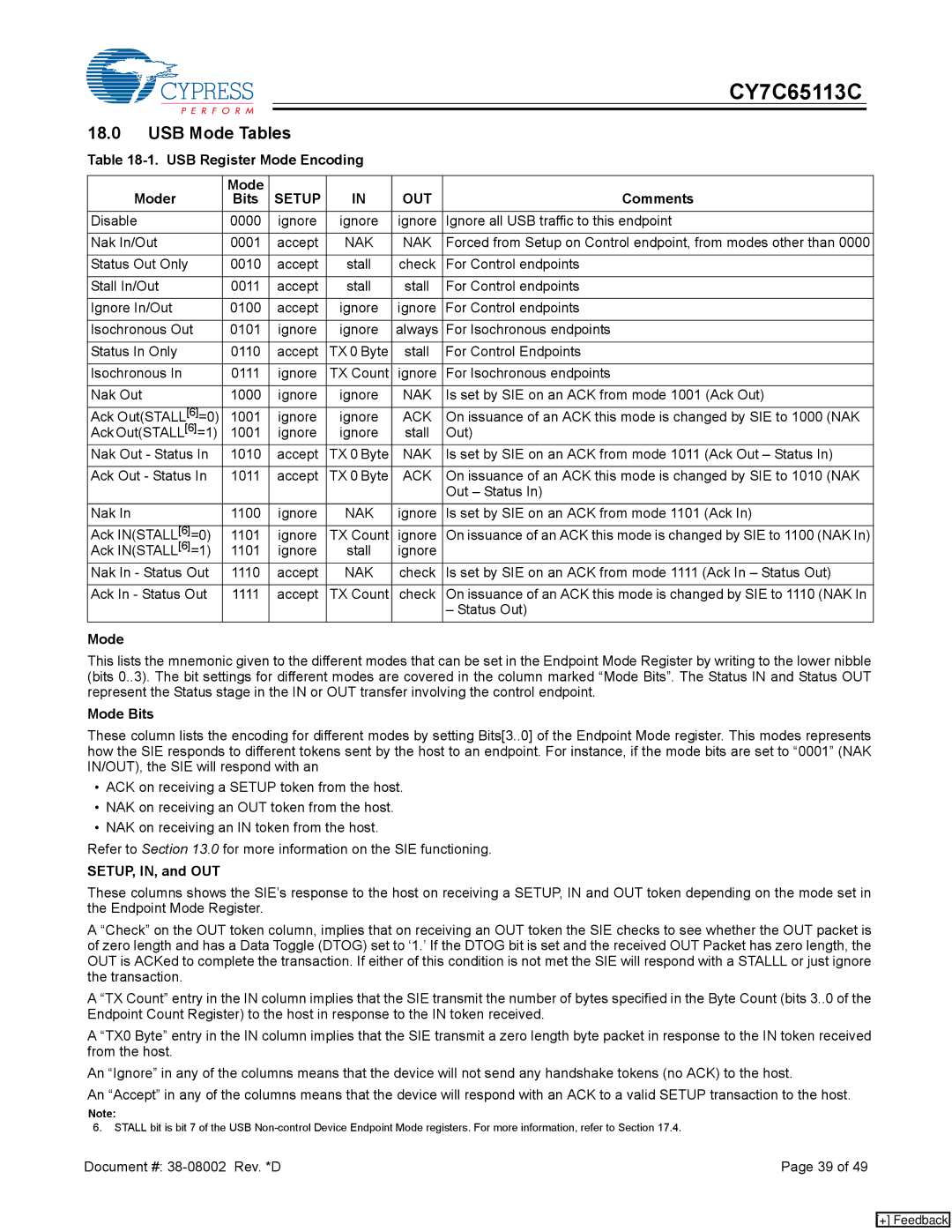
CY7C65113C
18.0USB Mode Tables
Table
Moder | Mode | SETUP | IN | OUT | Comments |
Bits | |||||
|
|
|
|
|
|
Disable | 0000 | ignore | ignore | ignore | Ignore all USB traffic to this endpoint |
|
|
|
|
|
|
Nak In/Out | 0001 | accept | NAK | NAK | Forced from Setup on Control endpoint, from modes other than 0000 |
|
|
|
|
|
|
Status Out Only | 0010 | accept | stall | check | For Control endpoints |
|
|
|
|
|
|
Stall In/Out | 0011 | accept | stall | stall | For Control endpoints |
|
|
|
|
|
|
Ignore In/Out | 0100 | accept | ignore | ignore | For Control endpoints |
|
|
|
|
|
|
Isochronous Out | 0101 | ignore | ignore | always | For Isochronous endpoints |
|
|
|
|
|
|
Status In Only | 0110 | accept | TX 0 Byte | stall | For Control Endpoints |
|
|
|
|
|
|
Isochronous In | 0111 | ignore | TX Count | ignore | For Isochronous endpoints |
|
|
|
|
|
|
Nak Out | 1000 | ignore | ignore | NAK | Is set by SIE on an ACK from mode 1001 (Ack Out) |
|
|
|
|
|
|
Ack Out(STALL[6]=0) | 1001 | ignore | ignore | ACK | On issuance of an ACK this mode is changed by SIE to 1000 (NAK |
Ack Out(STALL[6]=1) | 1001 | ignore | ignore | stall | Out) |
Nak Out - Status In | 1010 | accept | TX 0 Byte | NAK | Is set by SIE on an ACK from mode 1011 (Ack Out – Status In) |
|
|
|
|
|
|
Ack Out - Status In | 1011 | accept | TX 0 Byte | ACK | On issuance of an ACK this mode is changed by SIE to 1010 (NAK |
|
|
|
|
| Out – Status In) |
Nak In | 1100 | ignore | NAK | ignore | Is set by SIE on an ACK from mode 1101 (Ack In) |
|
|
|
|
|
|
Ack IN(STALL[6]=0) | 1101 | ignore | TX Count | ignore | On issuance of an ACK this mode is changed by SIE to 1100 (NAK In) |
Ack IN(STALL[6]=1) | 1101 | ignore | stall | ignore |
|
Nak In - Status Out | 1110 | accept | NAK | check | Is set by SIE on an ACK from mode 1111 (Ack In – Status Out) |
|
|
|
|
|
|
Ack In - Status Out | 1111 | accept | TX Count | check | On issuance of an ACK this mode is changed by SIE to 1110 (NAK In |
|
|
|
|
| – Status Out) |
Mode |
|
|
|
|
|
This lists the mnemonic given to the different modes that can be set in the Endpoint Mode Register by writing to the lower nibble (bits 0..3). The bit settings for different modes are covered in the column marked “Mode Bits”. The Status IN and Status OUT represent the Status stage in the IN or OUT transfer involving the control endpoint.
Mode Bits
These column lists the encoding for different modes by setting Bits[3..0] of the Endpoint Mode register. This modes represents how the SIE responds to different tokens sent by the host to an endpoint. For instance, if the mode bits are set to “0001” (NAK IN/OUT), the SIE will respond with an
•ACK on receiving a SETUP token from the host.
•NAK on receiving an OUT token from the host.
•NAK on receiving an IN token from the host.
Refer to Section 13.0 for more information on the SIE functioning.
SETUP, IN, and OUT
These columns shows the SIE’s response to the host on receiving a SETUP, IN and OUT token depending on the mode set in the Endpoint Mode Register.
A “Check” on the OUT token column, implies that on receiving an OUT token the SIE checks to see whether the OUT packet is of zero length and has a Data Toggle (DTOG) set to ‘1.’ If the DTOG bit is set and the received OUT Packet has zero length, the OUT is ACKed to complete the transaction. If either of this condition is not met the SIE will respond with a STALLL or just ignore the transaction.
A “TX Count” entry in the IN column implies that the SIE transmit the number of bytes specified in the Byte Count (bits 3..0 of the Endpoint Count Register) to the host in response to the IN token received.
A “TX0 Byte” entry in the IN column implies that the SIE transmit a zero length byte packet in response to the IN token received from the host.
An “Ignore” in any of the columns means that the device will not send any handshake tokens (no ACK) to the host.
An “Accept” in any of the columns means that the device will respond with an ACK to a valid SETUP transaction to the host.
Note:
6.STALL bit is bit 7 of the USB
Document #: | Page 39 of 49 |
[+] Feedback
